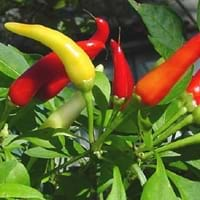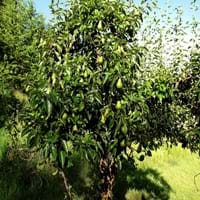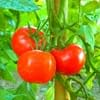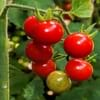Life Span
Annual
Perennial
Origin
Mexico, Central America, South America
Europe, Western Asia
Types
Not Available
Green Anjou, Red Anjou, Bartlett
Number of Varieties
Not Available
Habitat
Open areas
Humid climates, moist forests
USDA Hardiness Zone
Not Available
3-8
Sunset Zone
A1, A2, A3, H1, H2, 1a, 1b, 2a, 2b, 3a, 3b, 4, 5, 6, 7, 8, 9, 10, 11, 12, 13, 14, 15, 16, 17, 18, 19, 20, 21, 22, 23, 24
2a, 2b, 3a, 3b, 4, 5, 6, 7, 8, 9, 14, 15, 16, 17, 18
Habit
Upright/Erect
Oval or Rounded
Flower Color
White, Light Yellow, Ivory
White
Flower Color Modifier
Bicolor
Not Available
Fruit Color
Red, Green, Dark Green
White, Yellow, Red, Green, Yellow green
Leaf Color in Spring
Green
Light Pink, Red, Green, Light Green
Leaf Color in Summer
Dark Green
Dark Green
Leaf Color in Fall
Dark Green, Black
Purple, Dark Green, Burgundy
Leaf Color in Winter
Dark Green
Light Green
Leaf Shape
Elliptic
Oval with a pointed tip and fine teeth along their edges
Plant Season
Spring, Summer, Fall
Early Spring, Winter
Sunlight
Full Sun
Full Sun
Growth Rate
Medium
Medium
Type of Soil
Loam
Loamy, Sandy
The pH of Soil
Neutral
Acidic
Soil Drainage
Well drained
Well drained
Bloom Time
Indeterminate
Fall, Summer
Tolerances
Drought
Drought
Where to Plant?
Container, Ground, Pot
Ground
How to Plant?
Seedlings, Transplanting
Grafting, Seedlings
Plant Maintenance
Medium
Low
Watering Requirements
Do Not over Water
Medium, Water less during winter, Water more in summer, when new, water every week
In Summer
Lots of watering
Lots of watering
In Spring
Moderate
Moderate
In Winter
Average Water
Average Water
Soil pH
Neutral
Not Available
Soil Type
Loam
Not Available
Soil Drainage Capacity
Well drained
Not Available
Sun Exposure
Full Sun
Full Sun, Partial Sun
Pruning
Remove damaged leaves, Remove dead branches, Remove dead leaves
Remove damaged leaves, Remove dead branches, Remove dead leaves
Fertilizers
All-Purpose Liquid Fertilizer
Ammonium Nitrate, Fertilize the soil before planting
Pests and Diseases
fungus, Verticillium Wilt, Viruses
Red blotch
Plant Tolerance
Drought
Drought
Flowers
Insignificant
Yes
Flower Petal Number
Single
Single
Foliage Texture
Medium
Medium
Foliage Sheen
Glossy
Glossy
Attracts
Not Available
Aphids, Birds, Butterflies, Pear psylla
Allergy
Hives, Rash
Anaphylaxis, Digestive Problems, Itchiness, Swelling
Aesthetic Uses
Showy Purposes
Cottage Garden
Beauty Benefits
Not Available
Good for skin, Improve skin tone, Making cosmetics, Moisturizing, Skin Problems
Environmental Uses
Air purification
Air purification, Shadow Tree
Medicinal Uses
Diphtheria, Gout, Malignant Scarlet Fever, Paralysis
Cancer, Cardiovascular problems, cholesterol-lowering, Detox, Diabetes, Energy, Fiber, Heart problems, High blood pressure, Obesity, Treating diverticulosis, Weight loss
Part of Plant Used
Fruits
Bark, Fruits, Leaves
Other Uses
Used As Food
Used As Food
Used As Indoor Plant
No
No
Used As Outdoor Plant
Yes
Yes
Garden Design
Container, Edible, Herb / Vegetable, Tropical
Not Available
Botanical Name
CAPSICUM annuum 'Serrano'( Longum Group)
PYRUS communis
Common Name
Hot Chili Pepper, Serrano Pepper
Pear
In Hindi
Serrano Kali Mirch
नाशपाती
In German
Serrano Pfeffer
Birne
In French
Piment serrano
Poire
In Spanish
Chile serrano
Pera
In Greek
Serrano pepper
Αχλάδι
In Portuguese
Serrano pimenta
Pera
In Polish
Serrano pieprz
Gruszka
In Latin
Serrano piperis
Orbis
Phylum
Anthophyta
Vascular plant
Class
Not Available
Magnoliopsida
Family
Solanaceae
Rosaceae
Clade
Asterids, Eudicots
Angiosperms, Eudicots, Rosids
Subfamily
Solanoideae
Amygdaloideae
Season and Care of Serrano Pepper and Pear
Season and care of Serrano Pepper and Pear is important to know. While considering everything about Serrano Pepper and Pear Care, growing season is an essential factor. Serrano Pepper season is Spring, Summer and Fall and Pear season is Spring, Summer and Fall. The type of soil for Serrano Pepper is Loam and for Pear is Loamy, Sandy while the PH of soil for Serrano Pepper is Neutral and for Pear is Acidic.
Serrano Pepper and Pear Physical Information
Serrano Pepper and Pear physical information is very important for comparison. Serrano Pepper height is 60.00 cm and width 45.70 cm whereas Pear height is 1,219.20 cm and width 800.00 cm. The color specification of Serrano Pepper and Pear are as follows:
Care of Serrano Pepper and Pear
Care of Serrano Pepper and Pear include pruning, fertilizers, watering etc. Serrano Pepper pruning is done Remove damaged leaves, Remove dead branches and Remove dead leaves and Pear pruning is done Remove damaged leaves, Remove dead branches and Remove dead leaves. In summer Serrano Pepper needs Lots of watering and in winter, it needs Average Water. Whereas, in summer Pear needs Lots of watering and in winter, it needs Average Water.





